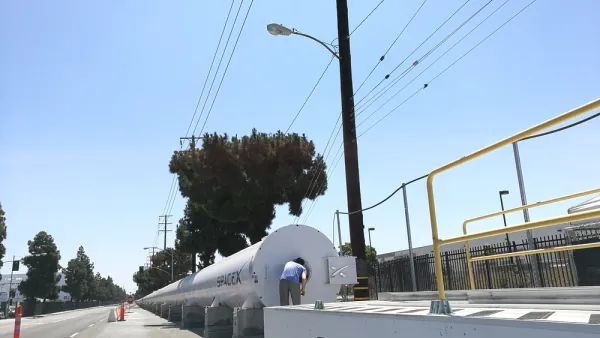About that Hyperloop report…

Aaron Gordon spoke to a number of transit and transportation experts and produces scathing criticism of the recent Great Lakes Hyperloop feasibility study released earlier this week.
The study, published by the Northeast Ohio Areawide Coordinating Agency and Hyperloop Transportation Technologies, estimated the price of the project at $29.8 billion and called for more studies of the project. Studies will be necessary, according to Gordon, because Hyperloop technology is totally unproven.
As such, a Hyperloop feasibility study is a strange document, somewhat like studying the conservation of the unicorn population after a few people strapped a horn onto a horse. As of this writing, Hyperloops have not transported any humans. The maximum speed a test pod has reached is 288 mph, well short of the advertised maximum velocity of 650 mph, or 700, or even 750 (the number varies article by article, not exactly a reassuring testament to the precision of their estimates).
The argument in favor of the Hyperloop doesn't just stop at travel speeds. The feasibility report also touts lofty economic development and job creation figures. There's a very large problem with those estimates, according to Gordon.
That all sounds real good except it’s also totally unclear how they arrived at these numbers. Despite the study’s 156-page length, it is extremely light on methodology or the assumptions baked into the calculations. In fact, any mention of study methodology or assumptions directs inquiring minds to an appendix. However, the feasibility study does not have an appendix, nor does the study’s landing page on NOACA’s website.
Gordon speaks to a number of experts who also noticed those discrepancies in the report, and they all express unequivocal caution at the idea that Hyperloop could possibly live up to the initial billing sold in the feasibility report.
Looming behind all of this Hyperloop discussion, are pressing needs on infrastructure and economic development investment that are already proven, and could provide tremendous benefit to the regions exploring the Hyperloop (the Great Lakes Hyperloop isn't the only one).
FULL STORY: Hyperloop Is The Midwest's Answer To A Question No One Asked

Analysis: Cybertruck Fatality Rate Far Exceeds That of Ford Pinto
The Tesla Cybertruck was recalled seven times last year.

National Parks Layoffs Will Cause Communities to Lose Billions
Thousands of essential park workers were laid off this week, just before the busy spring break season.

Retro-silient?: America’s First “Eco-burb,” The Woodlands Turns 50
A master-planned community north of Houston offers lessons on green infrastructure and resilient design, but falls short of its founder’s lofty affordability and walkability goals.

Test News Post 1
This is a summary

Analysis: Cybertruck Fatality Rate Far Exceeds That of Ford Pinto
The Tesla Cybertruck was recalled seven times last year.

Test News Headline 46
Test for the image on the front page.
Urban Design for Planners 1: Software Tools
This six-course series explores essential urban design concepts using open source software and equips planners with the tools they need to participate fully in the urban design process.
Planning for Universal Design
Learn the tools for implementing Universal Design in planning regulations.
EMC Planning Group, Inc.
Planetizen
Planetizen
Mpact (formerly Rail~Volution)
Great Falls Development Authority, Inc.
HUDs Office of Policy Development and Research
NYU Wagner Graduate School of Public Service



























